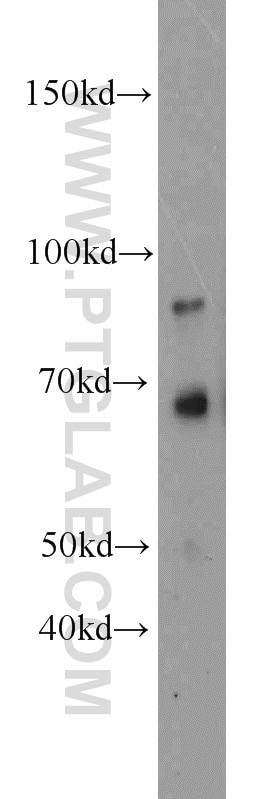KIRREL2 Polyklonaler Antikörper
KIRREL2 Polyklonal Antikörper für WB, ELISA
Wirt / Isotyp
Kaninchen / IgG
Getestete Reaktivität
human, Maus, Ratte
Anwendung
WB, IF, ELISA
Konjugation
Unkonjugiert
Kat-Nr. : 10890-1-AP
Synonyme
Geprüfte Anwendungen
| Erfolgreiche Detektion in WB | Mauslebergewebe |
Empfohlene Verdünnung
| Anwendung | Verdünnung |
|---|---|
| Western Blot (WB) | WB : 1:200-1:1000 |
| It is recommended that this reagent should be titrated in each testing system to obtain optimal results. | |
| Sample-dependent, check data in validation data gallery | |
Veröffentlichte Anwendungen
| IF | See 3 publications below |
Produktinformation
10890-1-AP bindet in WB, IF, ELISA KIRREL2 und zeigt Reaktivität mit human, Maus, Ratten
| Getestete Reaktivität | human, Maus, Ratte |
| In Publikationen genannte Reaktivität | human |
| Wirt / Isotyp | Kaninchen / IgG |
| Klonalität | Polyklonal |
| Typ | Antikörper |
| Immunogen | KIRREL2 fusion protein Ag1036 |
| Vollständiger Name | kin of IRRE like 2 (Drosophila) |
| Berechnetes Molekulargewicht | 75 kDa |
| Beobachtetes Molekulargewicht | 67 kDa, 90 kDa |
| GenBank-Zugangsnummer | BC007312 |
| Gene symbol | KIRREL2 |
| Gene ID (NCBI) | 84063 |
| Konjugation | Unkonjugiert |
| Form | Liquid |
| Reinigungsmethode | Antigen-Affinitätsreinigung |
| Lagerungspuffer | PBS with 0.02% sodium azide and 50% glycerol |
| Lagerungsbedingungen | Bei -20°C lagern. Nach dem Versand ein Jahr lang stabil Aliquotieren ist bei -20oC Lagerung nicht notwendig. 20ul Größen enthalten 0,1% BSA. |
Protokolle
| PRODUKTSPEZIFISCHE PROTOKOLLE | |
|---|---|
| WB protocol for KIRREL2 antibody 10890-1-AP | Protokoll herunterladen |
| STANDARD-PROTOKOLLE | |
|---|---|
| Klicken Sie hier, um unsere Standardprotokolle anzuzeigen |
Publikationen
| Species | Application | Title |
|---|---|---|
Nat Protoc Generation and long-term culture of human cerebellar organoids from pluripotent stem cells | ||
Life Med CRISPR/Cas9-mediated genetic correction reverses spinocerebellar ataxia 3 disease-associated phenotypes in differentiated cerebellar neurons |


